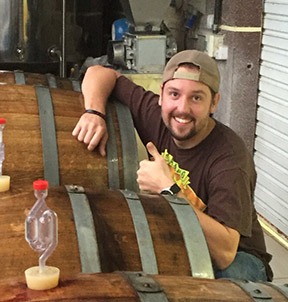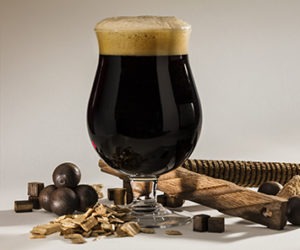Hopping for Bitterness
Early-boil hop additions are often called “bitterness additions” as adding bitterness is the primary purpose of this hop charge. That doesn’t mean variety and other factors shouldn’t be considered at this stage. While some brewers may just grab the hops with the highest alpha acid content, others think more critically about the final impact these early hop additions will have. Two pros share how they approach bitterness additions in their beers.

Chris Kirk co-founded Denver, Colorado’s, Banded Oak Brewing Co. in 2017. In 2025 he partnered with restaurant and bowling alley The Werks to start Paramount Beerwerks in Wheat Ridge, Colorado.
I like to use Hallertau Magnum as my typical bittering addition hop. I will also often use CTZ or Chinook in my IPAs and double IPAs. However, if I run out of a certain hop variety I would typically use for my bittering addition, I don’t worry too much and will substitute another variety to get me to my goal. Choosing a variety with a similar alpha acid percent is ideal, but a quick calculation can make a hop swap no sweat.
In my experience there will be a slight contribution of hop character that is reflected in the final product from your bittering additions — specifically tannins and phenolic acids. Especially if you’re bittering with a lower alpha acid hop for higher IBU beers. Bittering additions are typically economical decisions for me, but there are a few beers, typically with high protein additions like wheat or oats, that I like to add more hops with lower alpha acids to create a tighter bind in the boil with more polyphenols, resulting in a tight trub cone in the whirlpool and cleaner knockout.
My bittering additions are typically T-90 pellets. I have used T-45 pellets for bittering additions — the difference is the weight needed to get you to the same IBU. A small bag of hops can go a long way with T-45, but they typically cost more so the economics only make sense if you can find them for a really good price.
I definitely consider the early additions (75/60 minute boil) my main contributors to my IBU levels. I do attribute some bitterness to the flavor and aroma additions though and will factor that into my recipe development. In order to avoid too much contribution, I will design a heavily hopped beer so that I can use top up water at the end of my boil and pump in cold water to get my boil down fast at flame out and will add my whirlpool additions after the temperature of the wort gets down to around 200 °F (93 °C) to reduce isomerization.
I was around during the IBU wars of the 2010’s with things like the Alpha King Challenge and tongue numbing bitterness battles that breweries were participating in. I can remember trying beers with upwards of 500 IBUs. Now it’s just the opposite and breweries are trying to create massive dry hopping loads in the juicy and hazy IPAs. While my understanding of bittering has not really changed, my practice and philosophy has changed to meet the market demand. I still prefer to make and offer American and West Coast IPAs, but I have dialed my IBUs way down. My first IPA recipe that I was brewing in 2017 when we opened Banded Oak was 65 IBU and now it’s down to 26 as I’ve moved a majority of those early additions to late-boil and dry-hop additions.
My last bit of advice for homebrewers: Watch your pH levels. Alpha acids will have a slower isomerization rate in higher pH worts. And if you’re using hop substitutions, always calculate your weights to stay consistent with different alpha acid percents:
New weight = old weight x (original AA/new AA).

Josh Nard is the Head Brewer for Liquid Mechanics Brewing Co. in Lafayette, Colorado.
I have found hop variety decisions related to additions early in the boil are very important. Oil content, alpha acid content, as well as the amount of certain types of alpha acids play a vital role in bitterness quality of the resulting beer. These “bittering” additions can’t be thought of as only for adding bitterness —some hop character definitely makes its way through the boil process from early-boil additions too. I have found the percentage of cohumulone, as well as alpha acid percentage, typically make the biggest impact on the finished beer from this addition. IPAs in particular benefit from the “cleaner,” more refined bitterness of a low-cohumulone hop variety, so I usually use Warrior or Simcoe® for IPAs. For traditional lagers or low-ABV ales, I have found lower alpha acid noble varieties impart a more pleasant bitterness. I usually use Hallertauer Mittelfrüh, Tettnanger, or East Kent Golding T-90 pellets for these types of beers. If I really need more alpha acid, I supplement the noble varieties with Zuper Saazer or German Magnum.
For IPAs I have switched to some CO2 extract for bitterness. The extract seems to bring a little less vegetal bitterness than pellets. It also helps lower the quantity of vegetal matter in the kettle, allowing for better yield. Extract can create an oil slick in the kettle, though, so I typically throw some pellets into the boil with the extract to give that oil something to grab onto and incorporate into the liquid better.
I don’t do my bittering charge until 60 minutes into a 90-minute boil for West Coast IPAs. I get about 50% of the IBUs from that 30-minute addition of extract and pellets. I typically round out the rest with T-90 pellets at 15 minutes or later, and I always do a whirlpool addition.
Early in my career it was beaten into us that you need a 60-minute addition for IPAs. That later changed to a first wort hop. I did first wort hopping for a very long time, but it seemed the perceivable Bitterness Units (BUs) varied. I still like a first wort hop addition, but I use them rarely, simply for the ease of IBU calculation. Now, I like a 30-minute bittering addition, followed by lots of late additions. They used to call this “hop bursting.”
The landscape of IPA has changed a lot in the last decade or so. People (me included) seem to enjoy lower IBU IPAs with higher dry hop expression. I’ve learned a lot from brewing New England IPAs. It’s all about perceived bitterness and not particularly the calculated IBUs. Bitterness is one of the five basic tastes, and it’s not a very pleasant one in most cases. Figuring out how to incorporate bitterness into an enjoyable and refreshing experience is really the key. The less you boil, the more character you get from the hops. Just remember, it also means you get less BUs from the hops, which creates more hop load in the kettle, which I make up for with hop extract.
I have done mash hopping and I really enjoy doing it with whole cone hops. Pellets tend to stick up the mash. I usually wait for the sparge and just cover the top of the grain bed with whole cones. We’ve done several collaborations where we use mash hopping to mimic a hop back. I don’t think it makes a huge difference in the flavor of the beer, but we’ll take any opportunity to add even the most subtle hop character. At the very least, it makes the brewery smell amazing!
Let me leave homebrewers with a few pieces of advice. I enjoy the ease of calculating IBUs but it’s not something you should be beholden to. Trust your palate and adjust from there. You may find your IPA tastes best at 30 calculated IBUs rather than 80. You may find your Pilsner tastes better at 40 calculated IBUs rather than 30.
Don’t be afraid to experiment with all of the new hop products either. Professionals are still figuring out how to incorporate these new products, and homebrewers have a lot of flexibility in how they can experiment with them too. These products are definitely here to stay.
Lastly, make changes incrementally and always experiment. Change one small variable (variety, IBUs, hop product, etc.) and take notes. These small changes will inevitably inform a better product.



